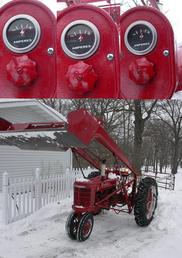I bought a Farmall H a week ago and have been using it to clear snow. When it wouldn"t start I noticed the battery was not taking a charge. It appears to have the original 6 volt system. Then I noticed the positive terminal of the battery is going up to the starter switch and negative going to the chassis. I understand these tractors were positive ground so it appears to be installed backwards. Is it possible this thing was somehow converted to negative ground? If not, what else is fried? Why did it start and run fine that way?
I don"t think the previous owner is going to be much help. I bought an operators manual but haven"t received it yet.
I don"t think the previous owner is going to be much help. I bought an operators manual but haven"t received it yet.


